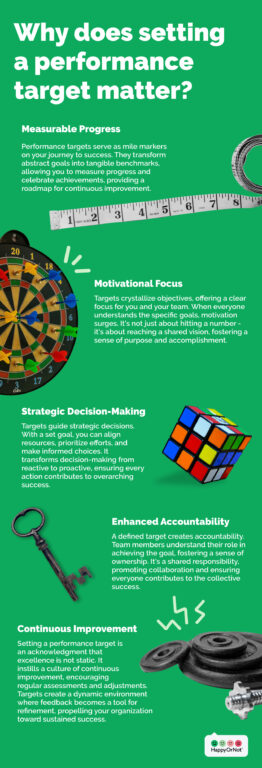How to set targets in HappyOrNot Analytics and why does it matter?
As you navigate through collected feedback, the ability to set a performance target in HappyOrNot Analytics emerges as a guiding force visible in the Summary widget.
This feature doesn’t merely measure your current triumphs but lay the groundwork for future conquests. Configuring default targets for groups and experience points becomes your roadmap, shaping the trajectory of new surveys and experiences.
Let’s delve into the significance of setting a performance target and unlocking the transformative power of goal-setting.
What does setting a performance target mean?
Once you’ve established a baseline with collected feedback, this feature allows you to define a specific goal visible in the Summary widget.
By configuring default targets for groups or experience points, you create a roadmap for success that shapes the trajectory of new surveys and experience points within that group. This not only measures your current success but sets the bar for future endeavors, aligning your efforts with a clear vision of achievement.
How to set a performance target?
Administrators can set up performance targets for their organization. The given target value becomes the benchmark for new surveys and experience points in that group.
Flexibility is key, as you can also set distinct targets for each group, experience point, or survey through individual settings. For a visual guide, a helpful video demonstrates the straightforward process of configuring targets, making goal-setting a seamless and empowering experience.
How to choose the right target?
Choosing the right target is a strategic decision, balancing ambition with realism. If measuring both customer and employee experience, consider distinct targets for each.
Above all, remember to keep it realistic – aim for a target that corresponds to your performance percentile in the industry. If uncertain of your baseline, a safe starting point is the top 50%, allowing adjustment as you gather more data.
You can tailor your targets to industry benchmarks. Make your targets reflect achievable excellence, propelling your performance to new heights.
Why does setting a performance target matter?

Measurable Progress
Performance targets serve as mile markers on your journey to success. They transform abstract goals into tangible benchmarks, allowing you to measure progress and celebrate achievements, providing a roadmap for continuous improvement.
Motivational Focus
Targets crystallize objectives, offering a clear focus for you and your team. When everyone understands the specific goals, motivation surges. It’s not just about hitting a number – it’s about reaching a shared vision, fostering a sense of purpose and accomplishment.
Strategic Decision-Making
Targets guide strategic decisions. With a set goal, you can align resources, prioritize efforts, and make informed choices. It transforms decision-making from reactive to proactive, ensuring every action contributes to overarching success.
Enhanced Accountability
A defined target creates accountability. Team members understand their role in achieving the goal, fostering a sense of ownership. It’s a shared responsibility, promoting collaboration and ensuring everyone contributes to the collective success.
Continuous Improvement
Setting a performance target is an acknowledgment that excellence is not static. It instills a culture of continuous improvement, encouraging regular assessments and adjustments. Targets create a dynamic environment where feedback becomes a tool for refinement, propelling your organization toward sustained success.
Conclusion
Setting performance targets weaves a thread of measurable progress, motivational focus, strategic decision-making, enhanced accountability, and a commitment to continuous improvement.
As your team rallies around shared objectives, the clarity of purpose fosters motivation. So, embrace the power of setting targets, for in doing so, you propel your organization toward sustained and transformative success.
Frequently asked questions
Why set a performance target?
Performance targets provide tangible benchmarks for success, enabling you to measure progress, foster motivation, guide strategic decisions, enhance accountability, and cultivate a culture of continuous improvement.
How do I initiate setting a performance target?
As an administrator, you can enable targets in Customization settings, and define default targets for groups or experience points. Flexibility allows distinct targets for each.
How can I choose the right target?
Keep it realistic, corresponding to your industry performance percentile. Start at the top 50% if uncertain.
Can I set different targets for customer and employee experiences?
Yes, consider distinct targets for each. Tailor your approach based on the unique dynamics of measuring both customer and employee experiences within your organization.
What’s the impact of setting performance targets on decision-making?
Targets guide strategic decisions by aligning resources and prioritizing efforts. It transforms decision-making from reactive to proactive, ensuring every action contributes to overarching success.